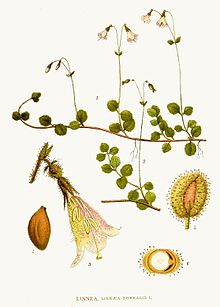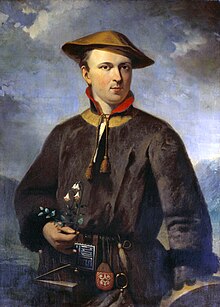Moss bells
| Moss bells | ||||||||||||
|---|---|---|---|---|---|---|---|---|---|---|---|---|

Moss bells ( Linnaea borealis ) |
||||||||||||
| Systematics | ||||||||||||
|
||||||||||||
| Scientific name of the genus | ||||||||||||
| Linnaea | ||||||||||||
| Gronov. ex L. | ||||||||||||
| Scientific name of the species | ||||||||||||
| Linnaea borealis | ||||||||||||
| L. |
The Moosglöckchen or Erdglöckchen ( Linnaea borealis ) is the only type of plant genus Linnaea in the family of Honeysuckle (Caprifoliaceae).
Description and ecology
Vegetative characteristics
The moss bell is an evergreen, creeping subshrub that reaches heights of about 20 centimeters. It roots up to 50 centimeters deep. From the age of 5 to 15, stolons running over the earth are formed. With the stolons a vegetative reproduction takes place and so one also finds in nature stocks that represent clones that are genetically identical. New branches sprout from the stolons. The branches are only about 3 millimeters in diameter.
The opposite arranged leaves are divided into a petiole and a leaf blade. The petiole is slightly hairy. The simple, relatively small leaf blade is rounded and slightly notched on the edge. The leaves are shed after about 12 to 16 months.
Generative characteristics
As a rule, the flowers sit in twos (hence the common English name "Twinflower") on an upright inflorescence stem. The flowers are nodding, with the corolla lobes pointing downwards. The strong fragrance of the flowers, reminiscent of vanilla, almonds or anise, is characteristic. The flower is surrounded by four cup-like bracts that the glandular hairy, under constant ovary enclose. The chalice is fivefold. The five pale pink petals are bell-shaped fused with five corolla lobes in monostrophic twisted bud cover, in the same sense of rotation as the loosestrife . There are four stamens . Nectar is produced. A solitary nut is formed that takes about 36 days from fertilization to maturity.
The number of chromosomes is 2n = 32.

Occurrence
The moss bell inhabits the boreal coniferous forests of the cool, temperate Holarctic , so it can be found in the northern regions and the high mountains of Eurasia and North America. In Central Europe it is extremely rare and only occurs in coniferous forests with a sufficient layer of moss . It is a character species of the order Piceetalia in Central Europe , occurs supraregionally mainly in plant communities of the Linnaeao-Piceion association but also in the Dicrano-Pinion association.
Systematics
Linnaea borealis is the only way the genus Linnaea in the family of Honeysuckle (Caprifoliaceae). All other species that were previously placed in this genus are now included in the genus Abelia .
The genus was named in 1737 after the Swedish botanist and systematist Carl von Linné , whose favorite flower it was. Linnaeus asked his wealthy friend and patron Jan Frederik Gronovius to give this name because he did not want to name this species after himself. The specific epithet borealis , which Linné added to the description of the species in 1753, means "coming from the north".
There are about three subspecies of Linnaea borealis :
- Linnaea borealis L. subsp. borealis in Europe and Asia
- Linnaea borealis subsp. americana (J.Forbes) Rehder : It occurs in North America and in Greenland.
- Linnaea borealis subsp. longiflora (Torr.) Hultén : It occurs in North America.
protection
Linnaea borealis subsp. borealis is particularly protected in Germany under the Federal Species Protection Ordinance.
Symbol and origin of the first name Linnea
The moss bell is the so-called Landskapsblomma ("landscape flower ") from Småland in Sweden. Carl von Linné was born and raised in this province.
Linnaea is considered the source of the name creation for the female first name Linnea, which has been widespread in Sweden since the early 19th century .
swell
- Comprehensive Overview of types (Engl.)
- Emil Giger: Linnaea borealis L., a monographic study , Zurich 1912 ( PDF ).
Individual evidence
- ↑ a b c Erich Oberdorfer : Plant-sociological excursion flora for Germany and neighboring areas . With the collaboration of Angelika Schwabe and Theo Müller. 8th, heavily revised and expanded edition. Eugen Ulmer, Stuttgart (Hohenheim) 2001, ISBN 3-8001-3131-5 , pp. 876-877 .
- ↑ Moss bells . In: BiolFlor, the database of biological-ecological characteristics of the flora of Germany.
- ↑ Lotte Burkhardt: Directory of eponymous plant names. Extended Edition. Botanic Garden and Botanical Museum Berlin, Free University Berlin Berlin 2018. online.
- ↑ Geiger 1912, pp. 2–3.
- ^ A b c Linnaea in the Germplasm Resources Information Network (GRIN), USDA , ARS , National Genetic Resources Program. National Germplasm Resources Laboratory, Beltsville, Maryland. Retrieved April 20, 2018.
Web links
- Linnaea borealis L., moss bell. In: FloraWeb.de.
- Profile and distribution map for Bavaria . In: Botanical Information Hub of Bavaria .
- Linnaea borealis L. In: Info Flora , the national data and information center for Swiss flora . Retrieved March 29, 2016.
- Distribution in the northern hemisphere according to Eric Hultén .
- Thomas Meyer: Data sheet with identification key and photos at Flora-de: Flora von Deutschland (old name of the website: Flowers in Swabia ).
- Profile of Plants of the North In: wonderful-lapland .
- Linnaea borealis at Linné on line - Uppsala University. (English)
- Linnaea borealis at the Linnean Society of London. (English)



